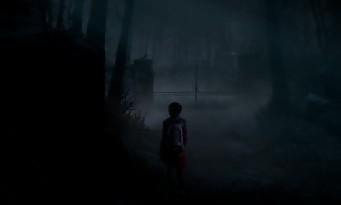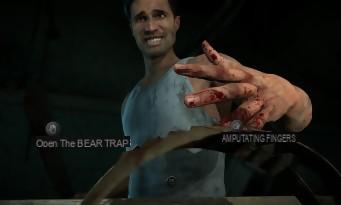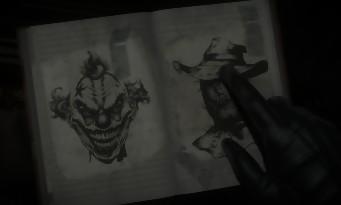 A mountain, snow, a band of seemingly tight-knit friends. Everything comes together to spend a nice evening by the fire, telling jokes or scary stories, and commemorating the tragic death a year earlier of two twins, whose bodies have never been found. But now, the story quickly turns to "Remember last winter" (yes, because it's winter, that's it). A strange atmosphere emerges from this privatized mountain, and we understand from the first minutes of play that we are not alone in loving the icy heights. Indeed, our eight protagonists are observed, even hunted, by a person who seems to prefer the sight of blood to that of powder. As they are seventeen years old, this is not necessarily what concerns them the most, Until Dawn also having a very pronounced teen-movie side, at least at the beginning of the adventure. Of course, the band splits up, couples form, and what was supposed to be a friendly reunion takes a completely different turn. To avoid making us lose the thread, this survival-horror of a new kind makes us embody each of the eight teenagers in turn, with, as in Heavy Rain, decisions to be made which will considerably influence the rest of the adventure. . This is also the central element of the gameplay, the one on which Sony and Supermassive Games have particularly insisted. Inevitably, when 70% of game time is devoted to narration, there is not that much room left for gameplay. To effectively tell an orchestrated game like a television series, the player must feel involved in the story. And nothing better to get there than a multiple-choice questionnaire, which forces you to think twice before making a decision. Given the turn of events, these choices are more dilemmas than anything else, of course.
A mountain, snow, a band of seemingly tight-knit friends. Everything comes together to spend a nice evening by the fire, telling jokes or scary stories, and commemorating the tragic death a year earlier of two twins, whose bodies have never been found. But now, the story quickly turns to "Remember last winter" (yes, because it's winter, that's it). A strange atmosphere emerges from this privatized mountain, and we understand from the first minutes of play that we are not alone in loving the icy heights. Indeed, our eight protagonists are observed, even hunted, by a person who seems to prefer the sight of blood to that of powder. As they are seventeen years old, this is not necessarily what concerns them the most, Until Dawn also having a very pronounced teen-movie side, at least at the beginning of the adventure. Of course, the band splits up, couples form, and what was supposed to be a friendly reunion takes a completely different turn. To avoid making us lose the thread, this survival-horror of a new kind makes us embody each of the eight teenagers in turn, with, as in Heavy Rain, decisions to be made which will considerably influence the rest of the adventure. . This is also the central element of the gameplay, the one on which Sony and Supermassive Games have particularly insisted. Inevitably, when 70% of game time is devoted to narration, there is not that much room left for gameplay. To effectively tell an orchestrated game like a television series, the player must feel involved in the story. And nothing better to get there than a multiple-choice questionnaire, which forces you to think twice before making a decision. Given the turn of events, these choices are more dilemmas than anything else, of course.
BUTTERFLY EFFECT
 This is also the strong point of the game, the butterfly effect touted in multiple trailers is really present. So, crushing a twig is not going to create an avalanche, but a badly mastered word in a conversation or a bad choice in the direction to take can very quickly lead to a series of negative decisions, which will irremediably lead to the death of a character, and this until the eight protagonists have breathed their last. Of course, the main objective is still the opposite, the ideal being to save all the heroes (unless you have the mentality of a psychopath). To achieve this, your choices will therefore be your best weapons, but your reflexes will also be of great use to you. During certain stages of escalation and escape, small QTEs quite arduous in terms of reaction time appear, and with the palpable tension, it is not uncommon to miss one or two. Which, of course, endangers or even permanently seals the fate of any of the teenagers. Another more interesting element of the gameplay: each interlude between the episodes is marked by a session with a very strange shrink, who invites us to define our fears, fears that we will find later in the game. The idea is cool, but we logically predicts what awaits us. However, Until Dawn succeeds in surprising us despite everything. On the other hand, the game has enormous replayability, with each decision being able to unlock different parts of the scenario. The adventure lasting a dozen hours in all, the desire to start again from the beginning or from a specific episode is quickly felt, just to modify a choice and see what happens after. You know, like when you watch a show and decide to rewatch one or more episodes because you think you missed something (True Detective fans will understand) or just because you loved it.
This is also the strong point of the game, the butterfly effect touted in multiple trailers is really present. So, crushing a twig is not going to create an avalanche, but a badly mastered word in a conversation or a bad choice in the direction to take can very quickly lead to a series of negative decisions, which will irremediably lead to the death of a character, and this until the eight protagonists have breathed their last. Of course, the main objective is still the opposite, the ideal being to save all the heroes (unless you have the mentality of a psychopath). To achieve this, your choices will therefore be your best weapons, but your reflexes will also be of great use to you. During certain stages of escalation and escape, small QTEs quite arduous in terms of reaction time appear, and with the palpable tension, it is not uncommon to miss one or two. Which, of course, endangers or even permanently seals the fate of any of the teenagers. Another more interesting element of the gameplay: each interlude between the episodes is marked by a session with a very strange shrink, who invites us to define our fears, fears that we will find later in the game. The idea is cool, but we logically predicts what awaits us. However, Until Dawn succeeds in surprising us despite everything. On the other hand, the game has enormous replayability, with each decision being able to unlock different parts of the scenario. The adventure lasting a dozen hours in all, the desire to start again from the beginning or from a specific episode is quickly felt, just to modify a choice and see what happens after. You know, like when you watch a show and decide to rewatch one or more episodes because you think you missed something (True Detective fans will understand) or just because you loved it.
A RED SUN RISES. A LOT OF BLOOD MUST have shed TONIGHT
 Technically, Supermassive Games releases a mastered product. A big highlight, the game can be based on first-rate facial motion-capture, with a level of detail that is simply incredible and actors whose faces are scrupulously respected. And relying on well-known names from the small screen, such as Hayden Panettiere (Heroes), Brett Dalton (Agents of SHIELD) or Rami Malek (Mr. Robot, Night at the Museum), Until Dawn offers an impressive cast for a video game. The bodies of the characters are however very rigid, with movements that we feel articulated in a robotic way. But that's about the only criticism that can be made in technical terms to Until Dawn, the game benefiting from a perfectly controlled environment, whether in the exploration phases or the cutscenes. Finally, we can not miss all the references that emerge from Until Dawn. The most obvious is of course Scream (the movies, not the TV show), if only for the storyline or the fact that the teenagers are kidnapped one by one. But we also find Saw in certain dilemmas, where a character must choose who, from his childhood friend or his beloved, is going to have his stomach cut off with a circular saw, all while a madman is talking in a suspended TV. And then, in the psychopath's costume, we find a mixture of inspiration from Stephen King's Ca and Friday the 13th. A set that proves how Until Dawn has succeeded in transposing the codes of slasher-movie to video games, so that the genre is sorely lacking in reference in the field. Maybe with this survival-horror, we have a new way to feel the nightmare and the horror on consoles.
Technically, Supermassive Games releases a mastered product. A big highlight, the game can be based on first-rate facial motion-capture, with a level of detail that is simply incredible and actors whose faces are scrupulously respected. And relying on well-known names from the small screen, such as Hayden Panettiere (Heroes), Brett Dalton (Agents of SHIELD) or Rami Malek (Mr. Robot, Night at the Museum), Until Dawn offers an impressive cast for a video game. The bodies of the characters are however very rigid, with movements that we feel articulated in a robotic way. But that's about the only criticism that can be made in technical terms to Until Dawn, the game benefiting from a perfectly controlled environment, whether in the exploration phases or the cutscenes. Finally, we can not miss all the references that emerge from Until Dawn. The most obvious is of course Scream (the movies, not the TV show), if only for the storyline or the fact that the teenagers are kidnapped one by one. But we also find Saw in certain dilemmas, where a character must choose who, from his childhood friend or his beloved, is going to have his stomach cut off with a circular saw, all while a madman is talking in a suspended TV. And then, in the psychopath's costume, we find a mixture of inspiration from Stephen King's Ca and Friday the 13th. A set that proves how Until Dawn has succeeded in transposing the codes of slasher-movie to video games, so that the genre is sorely lacking in reference in the field. Maybe with this survival-horror, we have a new way to feel the nightmare and the horror on consoles.


























